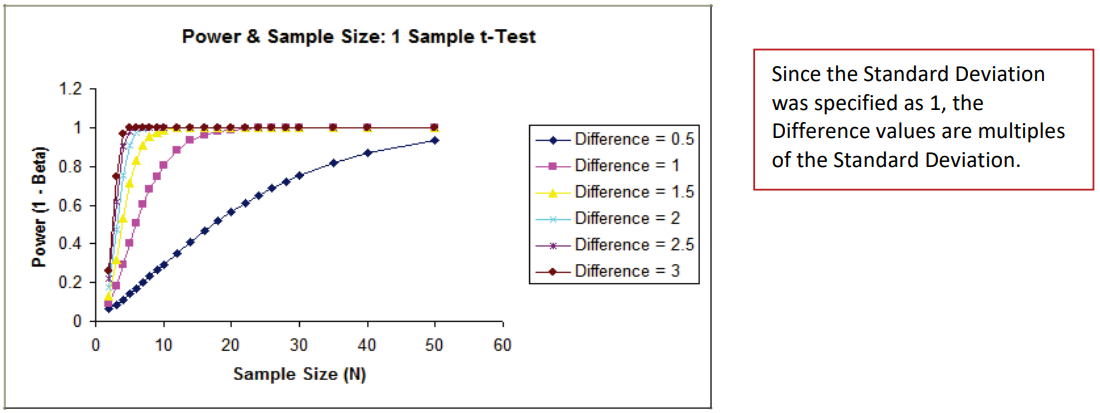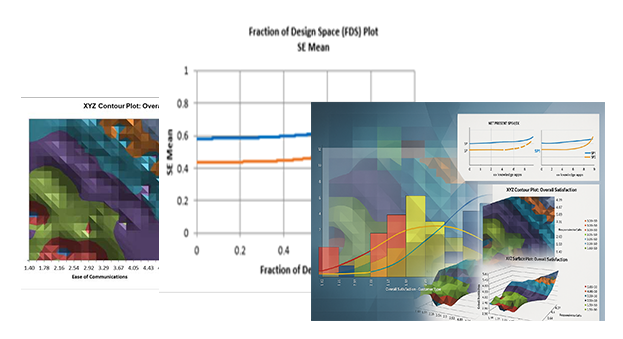How Do I Perform Power and Sample Size Calculations for a One Sample
t-Test?
Power and Sample Size One Sample t-Test Customer Data
Using the One Sample t-Test, we determined that Customer Types 1 and 3 resulted in Fail to
reject H0: μ=3.5. A failure to reject H0 does not mean that we have proven the null to be
true. The question that we want to consider here is What was the power of the test?
Restated, What was the likelihood that given Ha: μ≠3.5 was true, we would have rejected H0
and accepted Ha? To answer this, we will use the Power and Sample Size Calculator.
Tip: Typical sample size rules of thumb address confidence interval size and
robustness to normality (e.g. n=30). Computing power is more difficult because it involves
the magnitude of change in mean to be detected, so one needs to use the power and sample
size calculator.
Please use the following guidelines when using the power and sample size calculator:
Power >= .99 (Beta Risk is <= .01) is considered Very High Power
Power >= .95 and < .99 (Beta Risk is <=.05) is High Power
Power >= .8 and < .95 (Beta Risk is <=.2) is Medium Power. Typically, a power
value of .9 to detect a difference of 1 standard deviation is considered
adequate for most applications. If the data collection is difficult
and/or expensive, then .8 might be used.
Power >= .5 and < .8 (Beta Risk is <=.5) is Low Power not
recommended.
Power < .5 (Beta Risk is> .5) is Very Low Power do not use!
- Click SigmaXL >
Statistical Tools > Power and Sample Size
Calculators > 1 Sample t-Test
Calculator. We will only consider the
statistics from Customer Type 3 here. We will treat the
problem as a two sided test with
Ha: Not Equal To to be
consistent with the original test.
- Enter 27 in Sample Size
(N). The difference to be detected in this
case would be the difference between the sample mean and
the hypothesized value i.e. 3.6411 3.5 = 0.1411. Enter
0.1411 in
Difference. Leave
Power value blank, with
Solve For Power selected (default).
Given any two values of Power, Sample size, and
Difference, SigmaXL will solve for the remaining
selected third value. Enter the sample standard
deviation value of 0.6705 in
Standard Deviation. Keep
Alpha and
Ha at the default values as shown:
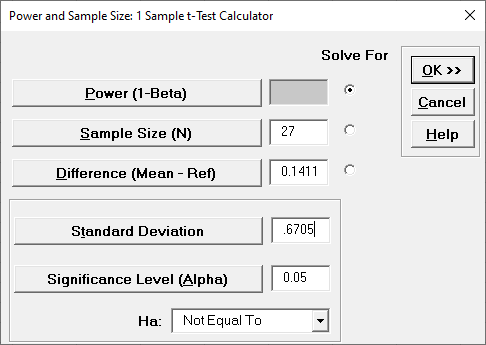
- Click OK. The
resulting
report is shown:

- A power value of 0.1836 is very
poor.
It is the probability of detecting the specified
difference.
Alternatively, the associated Beta risk is 1-0.1836 =
0.8164 which is the probability of failure to detect
such a difference. Typically, we would like to see Power
> 0.9 or Beta < 0.1. In order to detect a
difference this small we would need to increase the
sample size. We could also set the difference to be
detected as a larger value.
- First we
will determine what sample size would be required in
order to obtain a Power value of 0.9. Click
Recall SigmaXL Dialog menu or press
F3 to Recall Last Dialog. Select
the
Solve For Sample Size button as
shown. It is not necessary to delete the entered
sample size of 27 it will be ignored. Enter a
Power Value of .9:
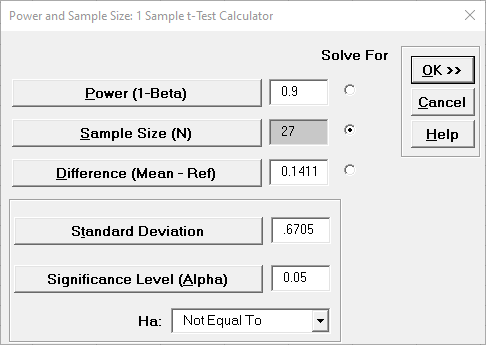
- Click OK. The
resulting report is shown:

- A sample size of 240 would be required to obtain a power
value of 0.9. The actual power is rarely the same as the
desired power due to the restriction that the sample
size must be an integer. The actual power will always be
greater than or equal to the desired power.
- Now we will determine what the difference would have to
be to obtain a Power value of 0.9, given the original
sample size of 27. Click
Recall SigmaXL Dialog menu or press
F3 to Recall Last Dialog. Select the
Solve For Difference button as
shown:
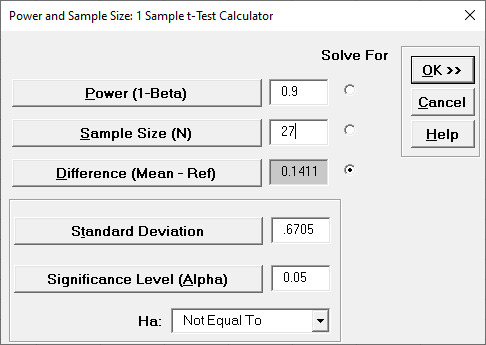
- Click
OK. The resulting report is shown:

- A difference of 0.435 would be required to obtain a
Power value of 0.9, given the sample size of 27.
Power and Sample Size One Sample t-Test Graphing the
Relationships between Power, Sample Size, and Difference
In order to provide a graphical view of the relationship
between Power, Sample Size, and Difference, SigmaXL provides
a tool called Power and Sample Size with Worksheets
. Similar to the Calculators, Power and
Sample Size with Worksheets allows you to solve
for Power (1 Beta), Sample Size, or Difference (specify
two, solve for the third). You must have a worksheet with
Power, Sample Size, or Difference values. Other inputs such
as Standard Deviation and Alpha can be included in the
worksheet or manually entered.
- Open the file Sample Size and Difference
Worksheet.xls, select the
Sample Size & Diff sheet tab. Click
SigmaXL > Statistical Tools > Power &
Sample Size with Worksheets > 1 Sample
t-Test. If necessary, check
Use Entire Data Table. Click
Next.
- Ensure that Solve For Power (1 Beta)
is selected. Select
Sample Size (N) and Difference columns
as shown. Enter the
Standard Deviation value of 1. Enter
.05 as the
Significance Level value:
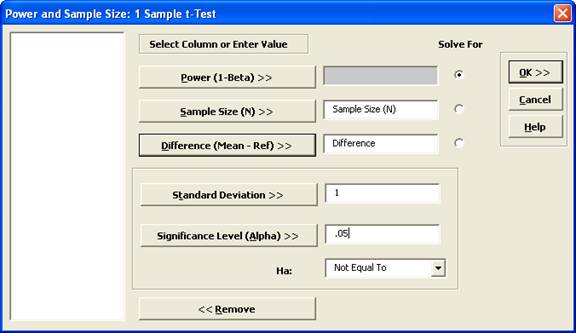
Note: By setting
Standard Deviation to 1, the Difference values will be a
multiple of Standard Deviation.
Click OK. The output report is shown
below:
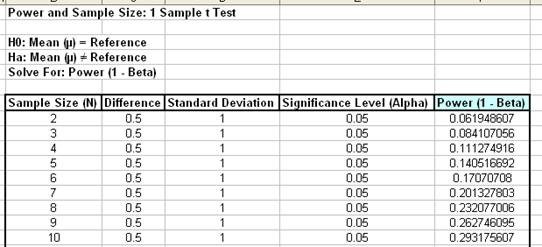
- To create a graph showing the relationship between
Power, Sample Size and Difference, click
SigmaXL > Statistical Tools > Power &
Sample Size Chart. Check
Use Entire Data Table. Click
Next.
- Select Power (1 Beta), click Y Axis
(Y); select
Sample Size (N), click X Axis
(X1); select
Difference, click Group Category
(X2). Click
Add Title. Enter Power & Sample
Size: 1 Sample t-Test:

- Click OK. The resulting Power &
Sample Size Chart is displayed:
